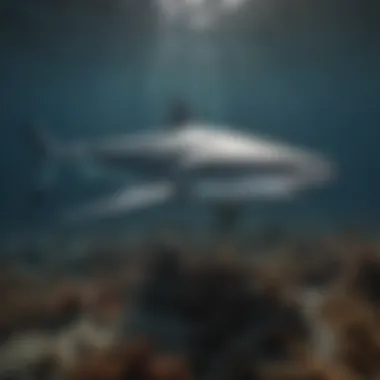Exploring Shark Habitats: Coastal to Open Ocean


Overview of the Topic
The global distribution of sharks is a reflection of their adaptability and complex behaviors. Understanding the habitats they occupy is essential for their conservation and management. Different species of sharks thrive in distinct environments, shaped by physical, chemical, and biological factors. This article aims to elucidate where sharks make their homes, spanning from coastal areas to the depths of the open ocean.
Shark habitats range widely, encompassing coral reefs, mangroves, estuaries, and the abyssal depths. Each of these environments possesses unique characteristics that influence the presence and behavior of various shark species. Therefore, identifying the specific ecological zones where sharks thrive not only aids in understanding their biological needs but also informs conservation strategies to protect them.
Current Status and Challenges
Sharks face numerous challenges due to human activities. Overfishing, habitat destruction, and pollution significantly impact their populations. According to recent studies, many shark species are experiencing decline, with some classified as endangered. The state of sharks and their habitats requires urgent attention, as their decline has cascading effects on marine ecosystems.
Some specific pressures include:
- Bycatch in commercial fishing: Often, sharks are unintentionally caught in fishing gear meant for other species.
- Habitat degradation: Coastal development and climate change are eroding the ecosystems that sharks depend on, such as mangroves and coral reefs.
- Pollution: Chemicals and plastics in the ocean pose direct threats to shark health and survival.
Sustainable Solutions
Addressing the challenges sharks face requires a multifaceted approach. Sustainable fishing practices are essential to ensure that shark populations remain stable. Moreover, marine protected areas have proven effective in safeguarding habitats critical for sharks and their prey.
Successful case studies, such as the implementation of no-take zones in the Bahamas, demonstrate the positive outcomes of conservation efforts. These protected areas help to restore shark populations and enhance ecosystem health, showcasing the potential of conservation initiatives.
Furthermore, public awareness campaigns are vital to educate communities about the importance of sharks in marine ecosystems. Engaging local fishers in sustainable practices often yields significant benefits for both businesses and marine wildlife.
Impact and Importance
The ecological role of sharks cannot be understated. As apex predators, they help maintain the balance of marine ecosystems. Their absence can lead to overpopulation of prey species, disrupting the food web. Thus, the conservation of sharks is integral for the health of oceans, which, in turn, affects human communities that rely on marine resources.
The future of sharks and their habitats is intricately linked to our choices today. Conservation efforts will not only preserve these magnificent creatures but also facilitate the resilience of marine ecosystems for generations to come.
"Protecting shark habitats is not just about saving a species; it's about ensuring the stability of oceanic ecosystems."
Oceans are vital to our planet's health. Recognizing the importance of sharks in these environments is crucial for developing effective conservation strategies.
Preface to Shark Habitats
The exploration of shark habitats is crucial to understanding the role these creatures play in marine ecosystems. Sharks are not just predators; they are an integral part of maintaining the balance within their habitats. Knowing where sharks reside helps in identifying the specific ecological zones that support their survival.
Sharks inhabit a range of environments from coastal regions to open ocean, each with unique characteristics. Understanding these habitats is essential for several reasons. It highlights the diversity of shark species that exist and the varying adaptations they have developed to thrive in their chosen environments. Additionally, studying these habitats sheds light on the ecological dynamics that impact shark populations, including food sources and reproductive zones.
Focusing on shark habitats opens a window to examine the broader implications of environmental changes. Various factors such as pollution, climate change, and habitat degradation directly affect where sharks can live. By investigating these issues, we gain insight that could inform conservation efforts and help protect these vital species before it's too late.
In summary, an in-depth exploration of shark habitats enriches our understanding of these magnificent animals. It provides a foundational perspective that can drive both research initiatives and conservation strategies aimed at ensuring the sustainability of shark populations in the wild.
Understanding Shark Ecology
Shark ecology encompasses the intricate relationships these species have with their environments. Sharks are highly adaptable creatures, capable of thriving in diverse marine settings ranging from shallow coastal waters to the vast depths of the ocean. This adaptability often depends on their physiological traits, such as their ability to regulate buoyancy, understand temperature variations, and locate prey.
The ecological role of sharks extends beyond their predatory nature. They help regulate fish populations, which contributes to healthier ocean ecosystems. Sharks often prey on sick or weak fish, thus promoting stronger and more resilient fish stocks. This predator-prey dynamic is vital for maintaining biodiversity in marine environments.
Shark species exhibit varying behaviors based on their habitat preference. For example, some species like the great white shark favor cooler waters often found near coastal regions. In contrast, the hammerhead shark migrates to warmer waters, highlighting the importance of corresponding habitat traits.
Shark habitats range widely, including:
- Coastal zones: These areas support a rich diversity of marine life and provide crucial breeding grounds for many shark species.
- Open ocean: Sharks like the whale shark can be found in vast pelagic environments, often along currents that facilitate their movement and feeding.
- Coral reefs and mangroves: These ecosystems provide critical habitats for many shark species, which rely on the complex structures for hunting and shelter.
In understanding shark ecology, we also consider anthropogenic impacts that threaten their habitats. From bycatch issues in commercial fishing to coastal development, many factors can disrupt the natural balance. Protecting habitats thus becomes a significant aspect of global conservation efforts.
With a solid comprehension of shark ecology, we can spark conversations that lead to meaningful changes in how we approach marine conservation, placing the well-being of sharks at center stage.
Geographical Distribution of Sharks
Understanding the geographical distribution of sharks is crucial for appreciating their role in marine ecosystems. Sharks inhabit a wide range of environments, from shallow coastal regions to the deep ocean. This distribution is not random; it depends on various factors including water temperature, salinity, and prey availability. Recognizing where different shark species are found helps conservationists identify critical habitats that need protection. These insights can guide management efforts aimed at sustaining shark populations and preserving the overall health of marine ecosystems.
World Oceans and Their Influence


The world oceans, comprising the Pacific, Atlantic, Indian, Southern, and Arctic Oceans, have a significant influence on shark habitats. Each ocean has its distinct features that affect the distribution of sharks. For example, the warmer waters of the Pacific Ocean attract a variety of shark species, as they thrive in higher temperatures. Conversely, the colder environments of the Arctic Ocean have limited species diversity.
Sharks are often found in coastal areas where they can hunt abundant prey. Areas like continental shelves are particularly vital. This is also where many juvenile sharks are born and grow. The availability of food sources and the right conditions are determining factors for their presence in specific regions.
"Sharks are not just ocean predators; they are important indicators of ocean health. Their distribution reveals much about the health of marine ecosystems."
Regional Variations
Regional variations in shark populations can provide insights into environmental changes and human impacts. For instance, in the Caribbean Sea, overfishing and habitat destruction have led to significant declines in shark populations. In contrast, some regions, such as the coasts of South Africa, are known for their rich biodiversity, hosting numerous shark species.
Furthermore, specific species of sharks have adapted to particular regional conditions. The great white shark prefers cooler waters found off the coast of California, while the tropical blacktip reef shark thrives in warmer coastal regions around coral reefs.
In summary, recognizing and studying the geographical distribution of sharks allows for better comprehension of their ecological roles and the conservation measures needed to protect these key marine species.
Coastal Ecosystems
Coastal ecosystems are pivotal for understanding shark habitats, as they serve as critical environments where these apex predators thrive. These ecosystems include areas such as mangroves, coral reefs, and estuaries. They provide essential ecological functions not only for sharks but also for an extensive array of marine species. The interplay between land and sea creates a rich tapestry of life, where species interact in ways that support their survival, breeding, and feeding.
One significant consideration of coastal ecosystems is their role as breeding and nursery grounds for various shark species. Many sharks require shallow waters with abundant food and protection to raise their young. The unique characteristics of these environments directly support shark populations and their life cycles. By maintaining healthy coastal ecosystems, we help ensure the sustainability of these marine creatures.
The benefits that coastal ecosystems provide to sharks are multi-faceted:
- Biodiversity: High species diversity ensures food availability for sharks, enhancing their foraging opportunities.
- Shelter: The structural complexity of habitats, such as mangroves and coral reefs, offers protection from predators.
- Water Quality: Healthy coastal habitats filter pollutants and provide clean water essential for shark health and habitat stability.
In summary, coastal ecosystems are not merely habitats; they are vital components of the marine environment that positively influence shark populations. By fostering healthy coastal areas, we contribute to the overall health of our oceans and the species that inhabit them.
Mangroves and Their Role
Mangroves are unique coastal forests that play a crucial role in the lives of many shark species. These trees thrive in intertidal zones and are specially adapted to saline conditions. Mangroves create intricate root systems that provide ideal nurseries for young sharks, offering protection from larger predators in open waters. The shallow waters around mangroves are teeming with small fish and invertebrates, providing abundant food resources for juvenile sharks.
Moreover, mangroves help stabilize coastlines and mitigate the effects of erosion and natural disasters. This stability allows shark populations to flourish. With increasing pressures from human development, the conservation of mangrove ecosystems becomes vital. Loss of mangroves can lead to a decrease in shark populations and the overall health of coastal marine environments.
Coral Reefs as Habitats
Coral reefs are among the most biodiverse ecosystems on the planet. They serve as important habitats for sharks, particularly for species such as the whitetip reef shark. Coral reefs provide hiding spots, hunting grounds, and breeding sites. The complex structure of the reef offers various niches where different marine organisms thrive, thus supporting a diverse food chain.
Sharks benefit from the abundance of prey found in coral systems. The health of coral reefs directly impacts shark populations. However, these ecosystems face challenges from climate change and pollution, which threaten their integrity. Protecting coral reefs is intrinsically linked to conserving shark species that depend on them for survival.
Estuaries as Shark Nurseries
Estuaries are transitional environments where freshwater meets saltwater. These areas are crucial for many shark species, serving as nurseries where young sharks can grow and develop in relative safety. The mix of nutrients from both land and sea creates a highly productive ecosystem that supports a wide variety of marine life.
Young sharks, such as the blacktip reef shark, often seek out estuarine waters for shelter and access to abundant prey. The protection offered in these regions is essential during their vulnerable stages of life. Unfortunately, estuaries are frequently threatened by urban development and pollution, leading to habitat degradation. Protecting these environments is essential for ensuring that shark populations have the necessary conditions to thrive.
"Healthy coastal ecosystems are foundational for the survival of shark populations, influencing their distribution and reproductive success."
Open Ocean Environments
Open ocean environments, also known as pelagic zones, are crucial for many shark species. These expansive areas are characterized by their depth and distance from shore, creating distinct ecological conditions. Sharks in these habitats exhibit adaptations that enable them to thrive in the vast, often cold, and nutrient-variable waters. Understanding these environments is essential for comprehending the ecological role sharks play in ocean health and their interaction with other marine species.
Pelagic Zones
Pelagic zones extend from the surface to the deep ocean. They are divided into several regions based on depth. The photic zone, where sunlight penetrates, supports a range of organisms, including smaller fish and plankton which serve as prey for larger fish and sharks. Sharks, such as the Great White, are commonly found in these areas due to the abundant food supply.
Sharks in pelagic zones exhibit unique behavior such as active hunting. They are known for their migratory patterns, often traveling long distances in search of food or favorable conditions. This zone is also characterized by its dynamic environmental conditions, influenced by factors such as ocean currents and water temperature.
Benefits of Pelagic Zones for Sharks:
- Abundant Food Sources: The high productivity in these zones attracts diverse marine life.
- Migration Opportunities: Sharks can travel long distances to follow prey or environmental changes.
- Less Competition: The vast space often allows sharks to occupy ecological niches with fewer predators or competitors.
Deep Sea Preferences
The deep sea represents another complex habitat for certain shark species. This environment is generally defined as areas deeper than 200 meters. It presents challenges, such as extreme pressure and low light levels, but also unique opportunities. Species like the Hammerhead shark can be found in these depths, adapting to the cold and dark conditions.
The deep sea is not as rich in food sources compared to the pelagic zones, but sharks have developed strategies to exploit what is available. This environment often hosts larger prey, like squid. The adaptations in feeding strategies are crucial to their survival in a less predictable habitat.


"Understanding sharks' preferences for deep sea environments can reveal their role in biodiversity and ecosystem health."
Considerations for Deep Sea Sharks:
- Adaptations to Pressure: Sharks need specialized bodies to withstand deep sea pressures.
- Hunting Tactics: They may rely on heightened senses to detect prey in dark waters.
- Vulnerable Ecosystem: As this habitat is affected by climate change and deep-sea mining, the conservation of its species is critical.
Behavioural Adaptations to Habitat
Sharks are not merely passive residents of their environments; they exemplify remarkable behavioral adaptations that enable their survival across diverse aquatic habitats. Understanding behavioural adaptations sheds light on how these apex predators interact within their ecosystems. The nuances of their hunting strategies and migration patterns reflect their responses to environmental variations, availability of prey, and protective instincts.
Hunting Strategies
Sharks employ various hunting strategies tailored to their habitats. These strategies are influenced by factors such as prey type, habitat structure, and even social behaviors. For instance, some species, like the great white shark, utilize an ambush approach, often breaching the surface to surprise seals. Conversely, the tiger shark takes on a more opportunistic method, scavenging and preying on various marine creatures when available.
Key hunting strategies include:
- Ambush Predation: Sharks use camouflage and stealth to catch prey off-guard.
- Active Pursuit: Some species, including blue sharks, can travel long distances to chase after fast-moving prey.
- Social Hunting: Hammerhead sharks often hunt in schools, increasing their efficiency when targeting schools of fish.
These strategies illustrate the adaptability of sharks. They are essential for their energy efficiency and survival. Different environments require different techniques, showcasing their evolutionary prowess.
Migration Patterns
Shark migration patterns provide further insight into their adaptability to habitat. Many species undertake extensive migrations in search of food or optimal breeding grounds. The migratory behaviours of species like the white shark or whale shark are influenced by temperature gradients and prey abundance. These patterns often correlate with seasonal shifts in marine ecosystems.
Factors affecting migration patterns:
- Temperature Regulation: Sharks often follow warm currents to maintain optimal body temperatures.
- Breeding: Certain species will migrate to specific areas for breeding, maximizing juvenile survival.
- Prey Availability: As food resources fluctuate, sharks alter their routes and timing.
"Sharks demonstrate behaviors that are punctuated by environmental stimuli, showcasing their adaptability and resilience within changing habitats."
Monitoring these patterns is crucial for conservation efforts. Understanding where and when sharks migrate can better inform protected marine areas and the implementation of sustainable fishing practices. In summary, both hunting strategies and migratory behaviors are instrumental to the survival and flourishing of sharks within their diverse habitats.
Impact of Environmental Changes
The impact of environmental changes on shark habitats is significant and multifaceted. Recognizing how these changes affect sharks is crucial for understanding their ecological roles. Considerations include the adaptation of sharks to varying conditions and how these influences shape their survival. It is essential to analyze climate change and pollution, as both pose threats to the delicate balance of marine ecosystems.
Climate Change Effects
Climate change affects sharks in various ways. Rising sea temperatures can alter their distribution patterns, forcing them to migrate to cooler areas. Warmer waters often lead to shifts in prey availability, impacting hunting opportunities for many shark species. As these predators rely on specific prey for sustenance, any disruption in food sources can hinder their survival.
In addition, ocean acidification is a concern. Increased carbon dioxide levels in the atmosphere lead to higher concentrations of carbonic acid in oceans. This condition can harm coral reefs and other vital marine habitats, diminishing places where sharks usually hunt or find shelter.
Sharks are also vulnerable to changes in ocean currents, which can affect their breeding grounds. Understanding these climatic effects helps conservationists create better management strategies for protecting shark populations.
"The future of many shark species hinges on our response to climate change and our ability to protect their habitats."
Pollution and Habitat Degradation
Pollution poses another challenge to sharks. Chemicals and plastics enter the oceans through various channels, affecting water quality. These pollutants may go up the food chain, ultimately impacting sharks through bioaccumulation. The ingestion of microplastics can lead to health issues for these creatures, like digestive problems or contamination with toxic substances.
Habitat degradation resulting from human activities also poses a threat. Coastal development, such as dredging or construction, can destroy essential shark habitats like mangroves and coral reefs. These ecosystems provide breeding and nursery areas essential for many shark species. Furthermore, sedimentation can cloud the waters, obstructing visibility, making it harder for sharks to hunt effectively.
Efforts to combat pollution and restore habitats are critical. Conservationists must advocate for stricter regulations and support community-based initiatives aimed at protecting these marine environments. Through education and active participation, we can work to ensure that sharks continue to thrive despite environmental changes.
Conservation Efforts
Conservation efforts for sharks are crucial due to their essential role in maintaining healthy marine ecosystems. These apex predators help regulate the populations of various marine species, providing stability within their habitats. Despite their importance, shark populations are declining at an alarming rate, primarily due to overfishing, habitat loss, and climate change. Therefore, protective measures are necessary to ensure their survival and the overall health of the ocean.
One notable method of conservation is the establishment of protected marine areas. These zones restrict human activities, enabling local marine life, including sharks, to thrive without significant interference. The benefits of these protected areas extend beyond just the conservation of sharks; they help improve biodiversity and support other marine species, which can lead to healthier ecosystems overall.
In addition to protected marine areas, promoting sustainable fishing practices is essential. Sustainable fishing ensures that fish populations, including sharks, are harvested at a rate that allows their populations to recover and thrive. Techniques such as catch-and-release fishing, using selective gears, and establishing fishing quotas can enhance the efficacy of these practices.
Therefore, it is important that conservationists, policymakers, and fishermen collaborate to create and implement effective strategies that protect sharks and their habitats. The success of these initiatives relies heavily on awareness and involvement from local communities and the public at large.


"Sharks are vital for ocean health; conserving them ensures the balance of marine ecosystems."
Protected Marine Areas
Protected marine areas (PMAs) are designated sections of the ocean where conservation efforts are prioritized. Such areas often prohibit activities like commercial fishing, mining, and oil drilling, enabling the local marine life to recover from human-induced stressors. These zones can vary in size and regulations, but they generally aim to reduce threats to marine biodiversity.
The implementation of PMAs has proven effective in supporting shark populations. For instance, areas like the Great Barrier Reef have seen improvements in shark numbers following the establishment of protection laws. By offering a safe environment, these zones contribute to the overall resilience of marine ecosystems, allowing for both reproductive success and growth of shark species.
In summary, PMAs serve as a sanctuary for sharks and other marine life. Continued research and monitoring are necessary to assess the effectiveness of these areas and adjust regulations as needed to maximize their benefits.
Sustainable Fishing Practices
Sustainable fishing practices focus primarily on managing fish stocks through responsible methods. This includes setting specific catch limits, using gear that minimizes bycatch, and implementing seasonal closures to allow fish populations to spawn and recover. These practices are paramount for maintaining a balanced ecosystem, where sharks can continue to thrive.
Some popular techniques include:
- Selective Gear: Using nets or traps designed to reduce bycatch can prevent the unintentional capture of sharks and other non-target species.
- Catch Limits: Setting quotas protects vulnerable shark populations from overfishing, allowing them to repopulate.
- Seasonal Closures: Temporarily halting fishing during breeding seasons enables sharks to reproduce and stabilize their populations.
Engaging communities in these practices is also vital. Education and outreach programs help fishers understand the long-term benefits of sustainability, fostering a culture of conservation. Such collaboration helps ensure the effective implementation of sustainable practices.
Future Research Directions
Future research on shark habitats is crucial for understanding the dynamics of these marine ecosystems. As various factors affect the distribution and behavior of sharks, ongoing study serves multiple benefits. It helps conserve shark populations and their habitats while revealing information that can guide policy decisions regarding marine biodiversity.
Research can lead to better management strategies by revealing the specific needs of different shark species. For example, knowing their preferred prey or environmental conditions allows for targeted conservation efforts. Additionally, as the global climate and human activities change, research becomes increasingly important to adapt to these dynamics effectively.
Sharks play a vital role in the sea ecosystem, acting as apex predators. Therefore, shifts in their population can lead to significant changes in marine environments. Understanding their habitats more thoroughly will help predict and mitigate adverse ecological impacts.
Technological Advances in Tracking
Recent advancements in technology have transformed the way researchers study shark habitats. Innovations such as satellite tags, genetic sampling, and underwater drones have enhanced the understanding of shark range and behavior. These tools provide valuable real-time data about their migrations and interactions with other species.
- GPS tracking allows scientists to monitor movements over long distances. Sharks can be tracked across oceans, providing insights into their migratory patterns.
- Acoustic tagging uses sound waves to detect where sharks are in relation to fixed stations. This helps map their habitat usage in real-time.
- Remote sensing technology offers data on environmental conditions such as temperature and ocean currents, which are vital to understanding shark ecology.
The fusion of technology with field studies presents a comprehensive view of shark habitats. It allows researchers to visualize how environmental changes affect sharks, which is essential for future conservation efforts.
Ecological Monitoring Programs
Ecological monitoring programs are essential for tracking the health of shark populations and their habitats. These programs collect vital data that informs conservation strategies and assesses the impact of environmental changes. Many such programs use a combination of field studies and data analysis.
- Habitat assessments evaluate the quality of environments where sharks reside. This helps identify areas at risk.
- Population surveys not only provide numbers but also show trends in breeding and juvenile shark populations, vital for assessing the success of conservation initiatives.
- Collaboration with local communities can enhance monitoring. Engaging fishermen and dive operators in reporting sightings increases the data pool and fosters a sense of stewardship.
Engaging in ecological monitoring creates a feedback loop. The data collected improves management and conservation strategies, which in turn reinforces the monitoring process.
Overall, future research directions in shark habitats must harness new technologies and foster collaborative relationships. This way, the understanding and protection of sharks can be continually refined, ensuring their survival for future generations.
End
Understanding shark habitats is crucial for several reasons. First, it highlights the ecological role sharks play in maintaining marine ecosystems. Their presence often indicates healthy ocean environments. Second, comprehending how sharks interact with their habitats sheds light on how various factors, like climate change and pollution, impact their populations.
This article has outlined key findings that reflect the complexity of shark-living environments. For instance, sharks inhabit a range of areas from coastal ecosystems such as mangroves and coral reefs to deeper pelagic zones. Each habitat presents unique challenges and resources that have shaped the behaviors and adaptations of different shark species. Recognizing these habitats informs better conservation strategies to ensure their survival.
Furthermore, increased awareness of the unique threats sharks face can drive action among policymakers and conservationists. When we appreciate the significance of diverse habitats from which sharks derive their sustenance and shelter, it becomes more evident why preserving these ecological zones is necessary.
"Sharks serve as indicators of ocean health, showcasing the well-being of their habitats and the overall marine ecosystem."
Thus, it is vital to promote initiatives aimed at protecting sharks and their environments. Conservation efforts must evolve alongside advancements in research, ensuring practices reflect the dynamic nature of marine ecosystems. By safeguarding the habitats that support these iconic species, we not only protect sharks but also the myriad of life interconnected in the ocean.
Summary of Key Findings
- Sharks occupy diverse habitats, including coastal regions and the open ocean.
- Specific environmental conditions influence shark distribution and behavior.
- Healthy shark populations are indicative of ecological stability.
- Understanding shark habitats enhances effective conservation measures.
- Climate change and pollution pose significant threats to shark habitats.
The Importance of Understanding Shark Habitats
Recognizing shark habitats is paramount for conservation. First, determining where sharks live allows for targeted protection efforts. For example, establishing marine protected areas in vital shark nurseries can enhance survival rates for juvenile sharks.
Second, understanding their habitats enables researchers to assess the effects of anthropogenic pressures on shark populations. As pollution and overfishing continue to threaten these environments, informed actions can mitigate negative impacts.
Lastly, educating the public on the significance of shark habitats fosters a culture of conservation. Increased awareness can drive community support for protecting these crucial areas. Organizations can lead initiatives to restore mangroves or coral reefs, ensuring these habitats remain viable for future shark generations.
In summary, knowledge of shark habitats not only enriches our understanding of marine life but also informs necessary actions for their protection and preservation.



